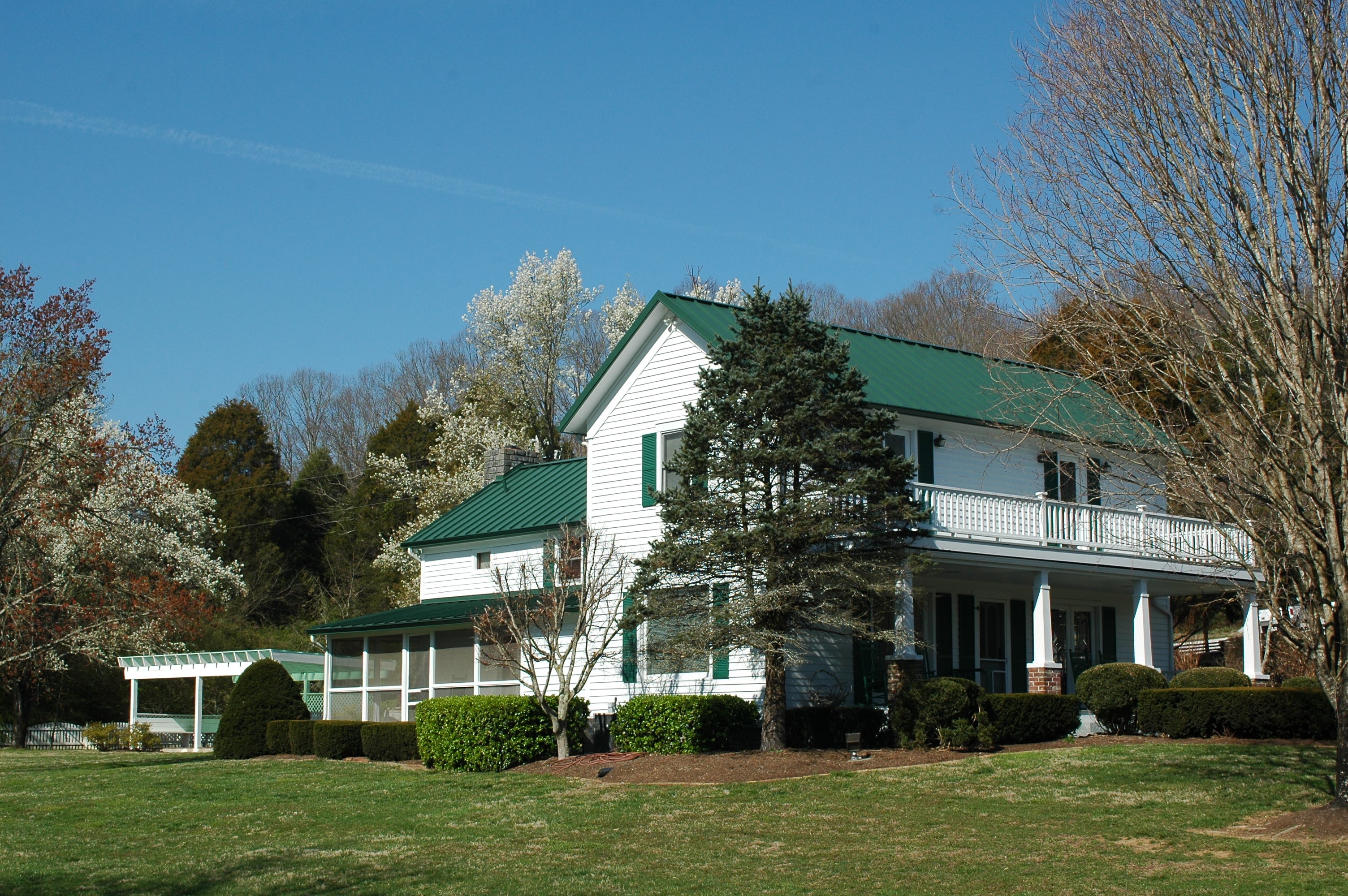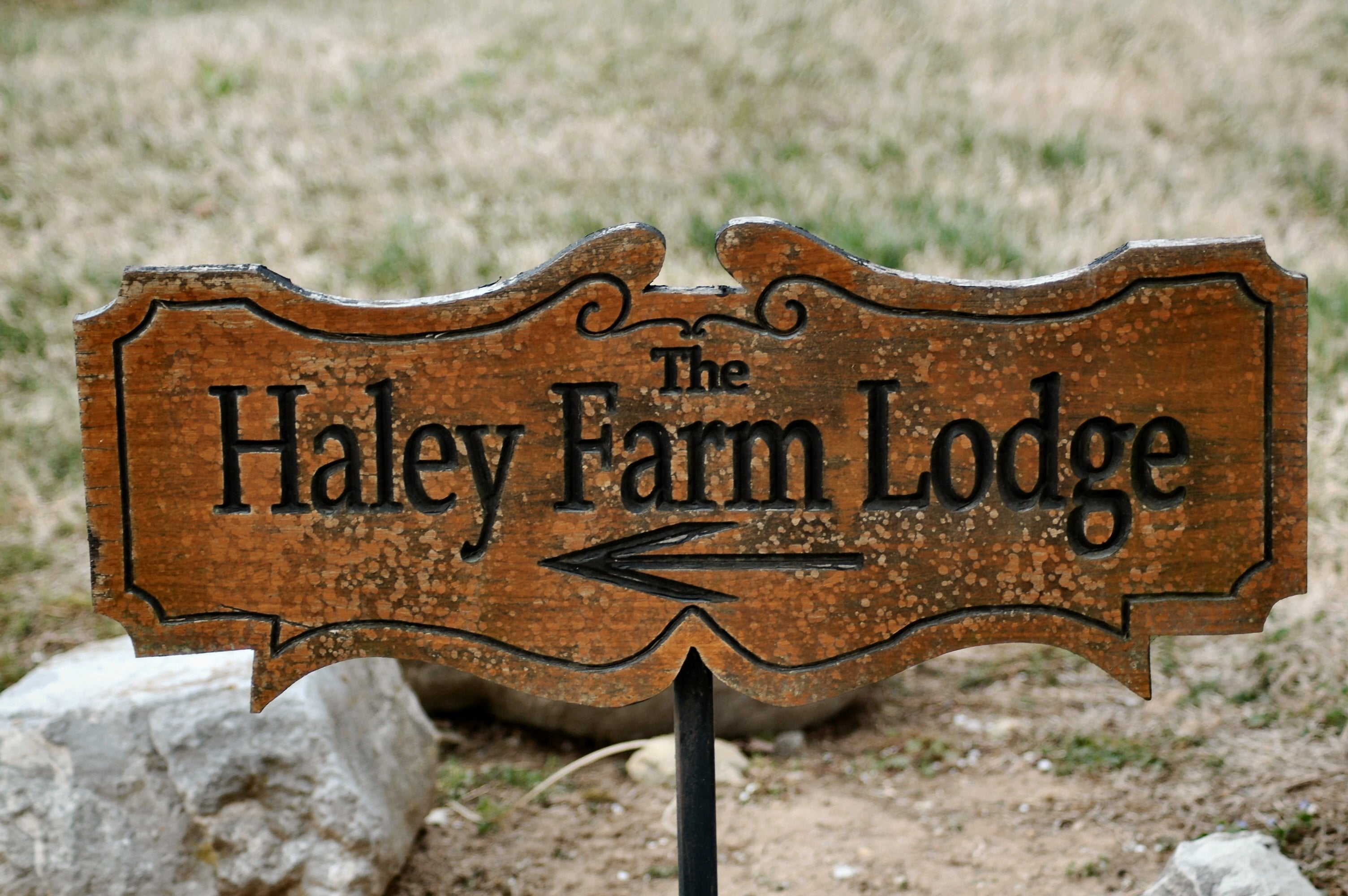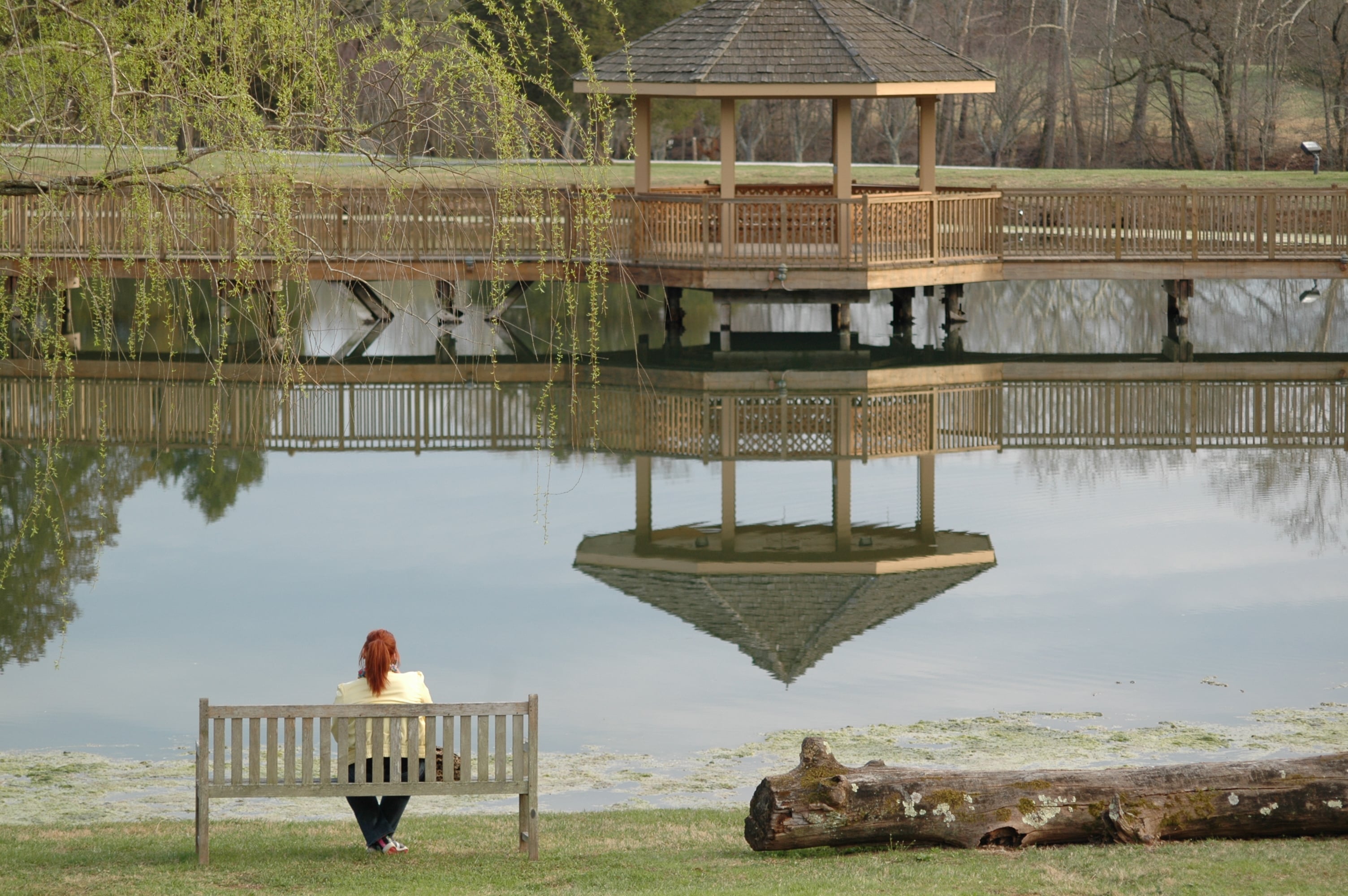CDF Haley Farm has a variety of spaces where we grow justice. Gathering spaces include Haley Lodge, the Langston Hughes Library, and the Riggio-Lynch Chapel. The ark-shaped chapel symbolizes the safe haven every child deserves. This beautiful, simple, functional and inspiring space is alive with great music and great preaching, prayer and worship, discussion and debate. The Riggio-Lynch Chapel and Langston Hughes Library were both designed by award-winning Vietnam Veterans Memorial designer Maya Lin. Guest cottages dot the grounds and serve as lodging spaces for special guests. Work spaces include staff offices and workshop rooms. Open spaces enjoyed at Haley Farm include a pond spanned by a bridge with gazebo, a prayer garden, outdoor labyrinth, apple orchard and a small stream. Outdoor sculptures are found in several locations. Gravel walking paths lead from one location to the next amid the sweeping green lawns as participants drink in the serenity this sacred space provides. Haley Farm is a smoke-free, drug- and alcohol-free, violence-free, hate-free, loving environment. Learn more about these spaces below.

Gathering Spaces
Riggio-Lynch Chapel
The beautiful ark-shaped Riggio-Lynch Interfaith Chapel symbolizes the safe haven all children need. The chapel’s simple, soaring form evokes Noah’s ark of protection, as well as the small boat drawn by seven-year-old Maria Coté featured as part of our logo. The chapel is constructed of cypress siding with a fir roof deck and beams and seats 250 people inside. The back of the chapel has doors that open entirely to connect the chapel interior with the rear portico.
An open courtyard links the chapel’s main structure to a smaller concrete block building which houses an office, a meeting room, kitchen facilities, bathrooms and a chapel bell tower. This building, in sharp contrast to the cypress exterior of the ark-like main building, was designed to resemble the type of building found in many shipyards where equipment and supplies are kept.
Building an interfaith chapel on the CDF Haley Farm grounds was Marian Wright Edelman’s dream from the start. The Riggio-Lynch Chapel was made possible by the generosity of Barnes & Noble CEO Leonard Riggio and his wife, Louise. After the events of Sept. 11, Mr. Riggio wanted to establish a place for people to find comfort, peace, strength and renewal.
The interfaith chapel is named in honor of Mr. Riggio and William (Bill) Lynch, former deputy mayor of New York City. Both long-time supporters of CDF, Mr. Riggio and the late Mr. Lynch each served on our Board of Directors. During the dedication service for the chapel on July 23, 2004, Mr. Riggio said, “In the ark design [is] a new metaphor for the Freedom Schools and a lasting symbol of our covenant to finish the unfinished work of the Civil Rights Movement.
The chapel is a place of safety and shelter for the hundreds of young people who come to Haley Farm each year to learn, worship and train to become the next generation of leadership for children and families.
Dozens of the nation’s greatest preachers have graced the pulpit of the Riggio-Lynch Chapel since 2004. The Rev. Dr. Eileen W. Lindner served as the first Dean of the Chapel. The Rev. Dr. Otis Moss, Jr. and the Rev. Dr. Otis Moss III preach there each summer as CDF Proctor Institute Co-Pastors-in-Residence.
Haley Lodge
Haley Lodge is the main meeting space at Haley Farm. It was built in 1989 by Mr. Haley to accommodate the many guests he liked to entertain at the farm. The downstairs boasts a large meeting and dining area with large stone fireplace, a private dining room or boardroom, three bathrooms, a commercial kitchen and a comfortable sunroom known as the Comer Room dedicated in memory of Shirley A. Comer. A second room is dedicated in memory of Alice Keliher, an early childhood educator who bequeathed us a significant gift from her very limited means. Upstairs there are six bedrooms with private baths and one three-room suite.
The artwork in Haley Lodge includes original illustrations by Bryan Collier, Caldecott Honor Book and Coretta Scott King Illustrator Award winner. The illustrations appear in the books Martin’s Big Words, written by Doreen Rappaport, and I’m Your Child, God: Prayers for Our Children, written by Marian Wright Edelman.
The rocking chairs on the Lodge porch bear plaques inscribed with names, a tradition started by Mrs. Edelman. Some of the plaques are in memory of late Civil Rights figures and others known for their work for justice. Other plaques honor leaders, friends and others still living.
The Langston Hughes Library
The Langston Hughes Library is a private, non-circulating, 5,000-volume reference collection and reading room. Dedicated in 1999 in honor of one of America’s most important and prolific writers, the library is used by children’s advocates, spiritual leaders, educators, civil rights leaders, authors, illustrators, publishers, scholars, teachers, librarians and students who come to Haley Farm for training, leadership development, reflection and inspiration. The reading room is named after acclaimed poet and novelist Dr. Maya Angelou and renowned historian Dr. John Hope Franklin. A sitting area is dedicated to civil rights heroine Rosa Parks.
Through the generosity of Barnes & Noble Chairman Leonard Riggio, and his wife, Louise, this cantilever barn was restored and recreated as a modern, comfortable, sky-lit reading room.
The library’s unique collection focuses on written works by African American authors, children’s picture books illustrated by African American illustrators, and books about the Black experience. The collection specializes in publications about children’s advocacy, spirituality, nonviolence, the Civil Rights Movement, with particular attention to the role of women, women’s leadership, African American history, literature, and culture, African culture and history and children’s literature. Special highlights of the collection are the hundreds of books that have been chosen as CDF Freedom Schools® books. These selections have been read by hundreds of children as participants in the CDF Freedom Schools program held in many cities across the country. Other highlights of the library collection include Children’s Defense Fund® publications, Federal government studies on child welfare, and signed first editions of books by renowned authors and illustrators.
The Langston Hughes Library plays host to important events, including:
- The Langston Hughes Library Roundtablebrought together authors, illustrators, librarians, scholars and publishers to discuss empowering children and youth through literature and the expansion of books presenting positive images of Black children
- The Langston Hughes Children’s Literature Festivalcelebrated the Harlem Renaissance poet Langston Hughes. The festival showcased Hughes’s poetry, fiction and non-fiction works for children through readings, visual arts, music and dance
- Each year, the Langston Hughes Library sponsors programs to inform the public with African American authors and their works. Middle school, high school and college students in the area visit the library for instruction in African American literature and to browse the collection housed in the library. Each February, the Langston Hughes Library participates in the national observance of the African American Read-In, sponsored by the National Council of Teachers of English (NCTE)
Other events at the library provide an open forum to nurture, teach and empower people to work on behalf of children.

Guest Houses
The White House
The White House has two bedrooms with a shared bath in the front and a loft bedroom, sitting room and bath in the back, as well as a living room, dining room, and eat-in kitchen.
When Alex Haley purchased this property on June 19, 1984, this farmhouse was one of only two structures on the property. The farmhouse dated back to 1830 and had an addition from the 1870s. Unoccupied for nearly 30 years before Mr. Haley’s purchase, animals roamed freely throughout the house, the floor had rotted and chimney collapsed. The house had no indoor plumbing or electricity. Although restoring the house was not cost-effective, Mr. Haley never considered tearing it down due to his love and appreciation for the history of the house and the people who had lived there. Mr. Haley’s former wife, Mia, nicknamed the house “Annie,” which she thought evoked the stable and peaceful feeling the house gave her.
Guests of Mr. Haley who spent time in the White House included Oprah Winfrey, whose room was painted purple; Maya Angelou; country-western singer Tom T. Hall; Quincy Jones, many in the original Roots cast, and former Tennessee Governor Lamar Alexander who was at the farm when contacted by President George Bush, Sr., asking him to serve as Secretary of Education.
CDF guests who have stayed at the White House include Dr. Gardner Taylor, Rev. Bill Coffin, and Dr. Samuel DeWitt Proctor.

The Wright House
The Wright House has two bedrooms and one bath downstairs, with a loft bedroom and second bath upstairs, along with kitchen and living room.
It was the last guesthouse built on the farm during Mr. Haley’s ownership and was completed in 1989.
The Wright House has been named in honor of Marian Wright Edelman’s family.
The Tobin House
The Tobin House features two bedrooms (one with an accessible bathroom), two baths, a kitchen, living room, and bonus loft bedroom.
This house was Mr. Haley’s place to relax, originally decorated to reflect his love of mallard ducks and known as the Duck House. Previous guests include Louis Gossett, Jr., Mrs. Sammy Davis, Jr. and her stepson who stayed after the death of Mr. Davis, and David Stephens, writer of the TV miniseries “Queen” who spent weeks at a time in the Duck House working on the script for the 1994 series based on the life of Alex Haley’s grandparents.
In 2010 it was renamed in memory of Lucius and Isabella Tobin, close friends of Mrs. Edelman’s parents. Rev. Dr. Tobin was for many years Professor of Religion at Morehouse College and pastor of Providence Baptist Church in Atlanta. Mrs. Tobin was perhaps Spelman College’s most generous alumna and her estate provided a generous gift to Haley Farm.
The Weaver House
The Weaver House features Murphy beds that fold up into the walls in two suites in the front of the house. Each suite has its own bath. There are two additional rooms in the back of the house and another bath. It also has a kitchen area.
It was originally named the Murphy House by Alex Haley.
The Weaver House was renamed in honor of George and Mary Weaver. George Weaver was Assistant Secretary of Labor during the Kennedy Administration and one of the first Black citizens to receive a Presidential appointment.
The Bethune-Height House (Lil’ Log Cabin)
The Bethune Height House has one bedroom with twin beds, living room with sleeper couch, small kitchen area, and bath.
Mr. Haley discovered this little cabin while visiting the local Museum of Appalachia. He purchased it from museum owner John Rice Irwin and had it brought to the farm and reassembled. The cabin was brought from Roane County, Tennessee, and originally belonged to the family of the late Texas Senator Sam Rayburn. It is believed that Senator Rayburn (1882–1961) was born in the cabin.
In July 2001, we renamed the cabin the Bethune-Height House in honor of Mary McLeod Bethune and Dorothy Irene Height. Dr. Height was a long-time CDF Board member and attended several events at Haley Farm. The dedication of this house coincided with a two-day symposium on the role of women in the Civil Rights Movement.
Mrs. Bethune founded Daytona Normal and Industrial Institute for Negro Girls (now Bethune-Cookman College) in Daytona Beach, Florida, in 1904 and organized the National Council of Negro Women (NCNW) in 1934. She was appointed by President Franklin Roosevelt as Director of African American Affairs for his administration.
Dr. Height continued the work started by Mrs. Bethune and served for many years as President of the NCNW (1957–1997) and as its Chair and President Emerita until her death in 2010. During the Civil Rights Movement, Dr. Height organized “Wednesdays in Mississippi,” which brought together Black and White women from the North and South to create a dialogue of understanding. Dr. Height also counseled First Lady Eleanor Roosevelt, encouraged President Dwight Eisenhower to desegregate public schools, and worked with President Lyndon Johnson to secure appointments for African American women to important government positions.

Work Spaces
The Hill House
Hill House serves as the main office for CDF Haley Farm.
Built in 1986, this was the first new building built by Mr. Haley who chose to live there rather than the renovated farmhouse. Before Haley Lodge was built, the Hill House was used to prepare meals for Mr. Haley’s parties and visiting guests since it had a large kitchen that occupied the entire present-day office area and kitchen. After Haley Lodge was completed, the kitchen in this house was downsized and the remaining space converted into a bedroom and sitting room, where Mr. Haley spent much time writing articles for Readers’ Digest.
The Business Center and Brown Building offer workshop spaces as well as providing space for laundry, offices, and other day-to-day operations.
Outdoor Spaces
Norton Pond and the Gazebo
The serene center of Haley Farm, Norton Pond and the Gazebo attract pensive participants, rock-skipping children, and flocks of geese alike.
Dug in 1985, the pond has a bottom packed with red clay. The bridge and gazebo across the pond were completed in 1989. The pond was home to the many mallard ducks that Mr. Haley loved and two white swans.
Today, the Langston Hughes Library is cooled and heated through a geo-thermal cooling system using water from the pond. The pond is named in honor of CDF supporters Peter Norton, a computer software entrepreneur, and Eileen Norton, a former CDF Board member.
The Haley Farm Prayer Garden
The prayer garden at Haley Farm was dedicated to Gordon and Mary Cosby in July 2003 during the Samuel DeWitt Proctor Institute for Child Advocacy Ministry.
Reverend Cosby, his wife Mary and a handful of others founded the Church of the Saviour in Washington, D.C. in 1947 as an independent church with a strong emphasis on commitment to spiritual growth (the inner journey) and mission (the outer journey). To keep the church small, Church of the Saviour eventually formed “little churches” around housing, children, hospitality, polyculturalism, public policy and retreat. New churches continue to be born out of a call to new missions, including health care for the homeless, drug addiction counseling and support, assistance for the poor, the young, and the elderly, and neighborhood renewal.
Jimilu Mason, a resident of Alexandria, Virginia and member of Church of the Saviour, sculpted the “Leave No Child Behind” statue. Her sculptures appear in the Smithsonian’s National Portrait Gallery, the U.S. Supreme Court, and the U.S. Capitol and can be seen in collections all over the world.
The Apple Orchard
Each summer, Haley Farm holds “Apple Picking Days.” We serve cookies and lemonade and invite the public to come and pick all of the apples they can carry.
In doing so, we continue Alex Haley’s tradition of hospitality. He had 220 apple trees planted in this orchard in 1989 and loved to serve his guests food made from their fruit, including apple butter, applesauce and apple fritters.
The Labyrinth
Labyrinths, unlike a maze, are flat to the ground, visible in their entirety from the entrance, and offer only one continuous path into the center and back out. Like other forms of meditation, walking a labyrinth may serve as a time to concentrate on a challenge or difficulty, to focus on a thought or emotion, to heighten awareness of the present moment or to ponder deep questions of faith.
Our president spent a week at Chartres Cathedral in Chartres, France, with the director of San Francisco’s Grace Cathedral labyrinth project who helped bring the labyrinth meditation movement to America. Our labyrinth is patterned after the labyrinth on the floor of the Chartres cathedral which was created between 1190 and 1210 A.D. CDF’s outdoor labyrinth was constructed by Stuart and Mary Bartholomaus on July 3, 1998, using a push mower with a 20-inch blade. In the winter, a canvas labyrinth with the same pattern is used inside Haley Lodge or the Riggio-Lynch Chapel.

